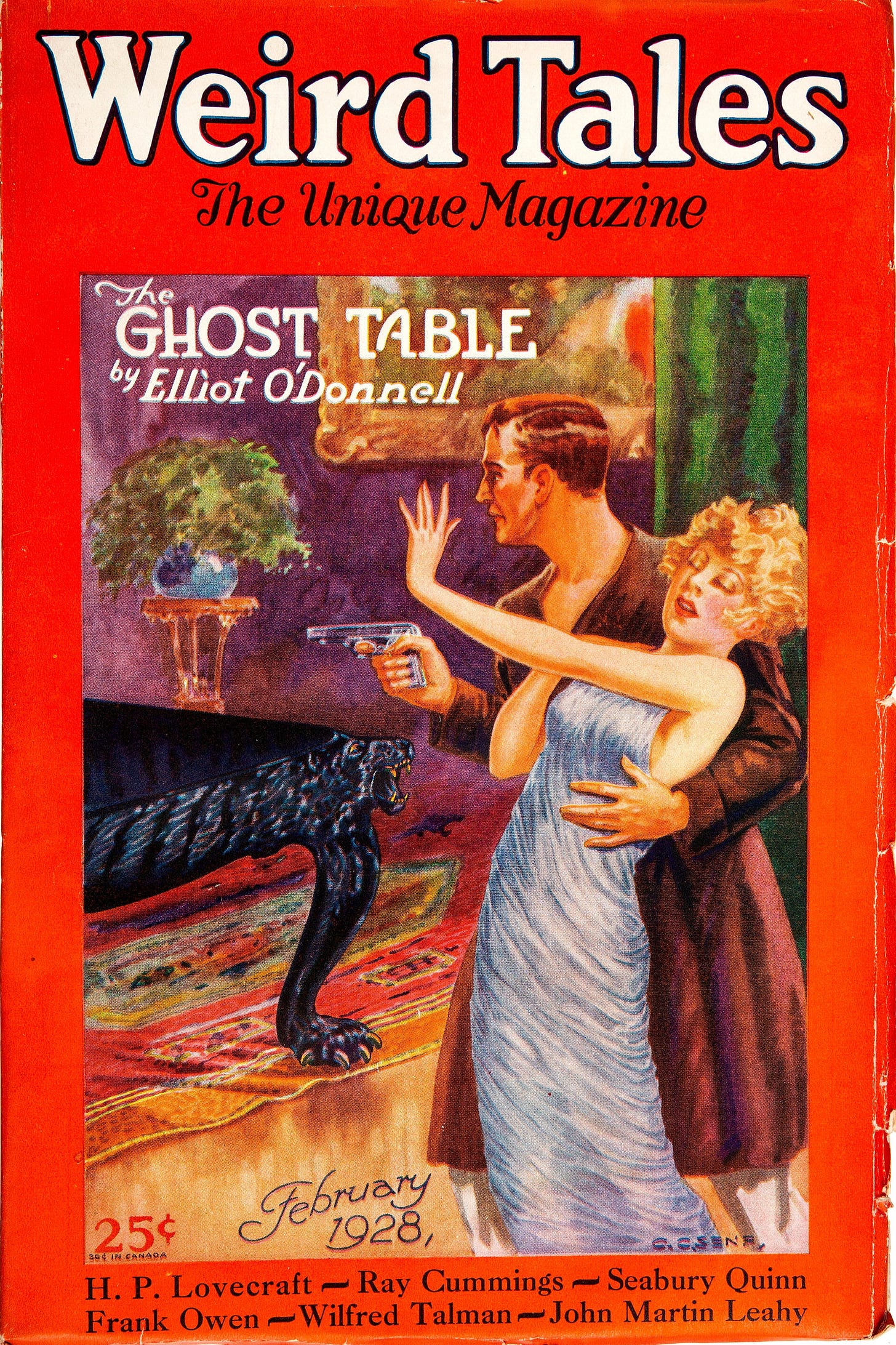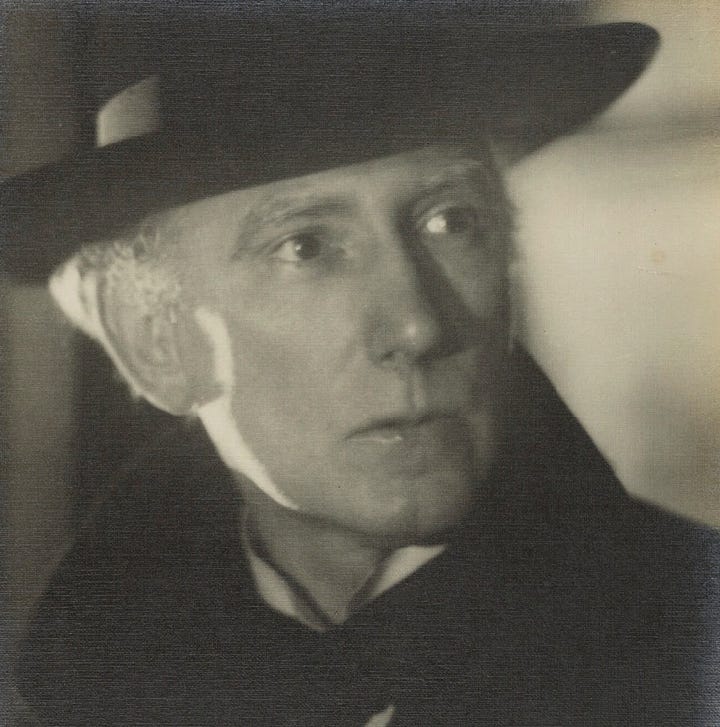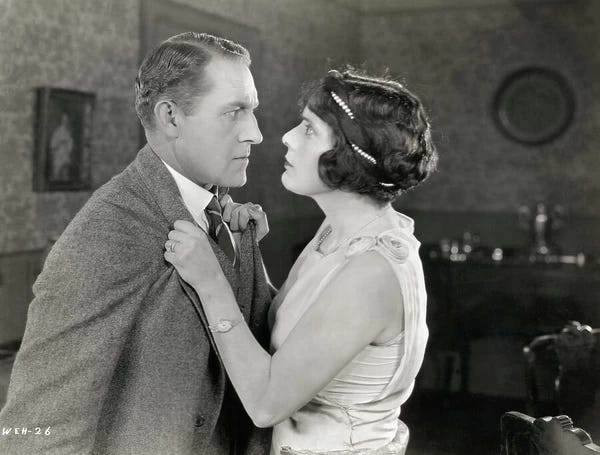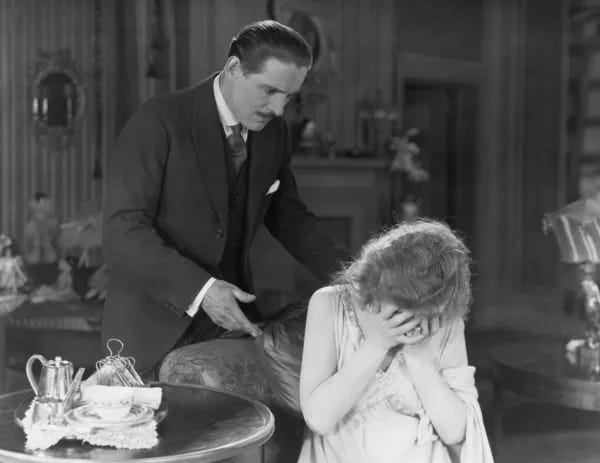"THE GHOST TABLE" (1928) Has a Clawed Foot on My Neck
Weird Tales asks, "Do you respect wood?"
Sometimes the algorithm skips the foreplay and injects the dopamine straight into my carotid artery. Yesterday, Instagram showed me a video by Dinesh Shamdasani, a collector flipping through his recently-acquired copy of Weird Tales, February 1928. I did several double takes throughout the video, because the evil entity on the cover is a table.
Like, a table table. Which is strange, since Weird Tales covers typically just feature bare-assed women being chained to giant idols or hurled into acid pits by ethnically-suspect viziers. So this one’s a departure from the norm, for sure.

In our current timeline, Weird Tales Feb. 1928 (you can peruse the issue here) commands historical importance because it premiered H.P. Lovecraft’s watershed story “The Call of Cthulhu.” The story marks the first appearance of the eldritch god, and is one of Lovecraft’s first movements toward the cosmic mythos that would become, as Michel Houellebecq puts it, “a gigantic dream machine” for alienated outcasts under liberalism, a supreme articulation of human anxiety within a modern world “where fear mounts in concentric circles, layer upon layer… [and] our only destiny is to be pulverized and devoured.”1
None of which actually matters, however, because (as mentioned before) the cover illustration of Weird Tales Feb. ‘28 is a man fighting a table.
The furniture in question, adorned with tiger’s head, menaces the couple. It may have just moved; there’s a slight muss in the carpet by its foot. Our hero, wearing a Hefner-style smoking jacket, cradles a swooning pinup in one arm whilst brandishing a pistol with the other, presumably unloading rounds into the lacquered hardwood. Eat lead, you four-legged son of a bitch!
I sent screenshots of “The Ghost Table” to a lot of people, mostly to the effect of “LOL Ghost Table” and “Do you respect wood?” And I’m ashamed to admit that my reason for seeking out the story itself was to have a chuckle at its expense.
Amateur mistake, as any narrator could tell you. As it turns out, Elliott O’Donnell was waiting for me behind the corner with a baseball bat. In fact, Elliott O’Donnell jumped me and took everything I had.
Readers, “The Ghost Table” is fantastic.
A bit about O’Donnell, the writer: he was a celebrity contributor to Weird Tales, a world-famous paranormal investigator who by 1928 had already published several decades’ worth of ghost stories, novels, and tell-all books about his encounters. An Englishman of Irish heritage (to which he credited a streak of extrasensory perception in his family), O’Donnell grew up in a house inhabited by banshees — one peaceable, one evil — and saw his first ghost at the age of five.2 As a young man, he travelled through America seeking his fortune, unsuccessfully (although in Oregon, he saw a creature similar to what we’d now call Bigfoot, and in Chicago encountered a haunted room of mannequins.). Returning to Britain, O’Donnell continued his investigations and writings on the “superphysical,” and garnered significant fame for his tales.


Immersed as he was in the ghostly and bizarre, O’Donnell also positioned himself as an anti-dogmatist and anti-crackpot. (Like his fellow Weird Tales presence,3 Houdini, he wrote denunciations of the Spiritualist and Theosophist movements, criticizing their oft-predatory seances.) In his book Werwolves, O’Donnell summarized his personal epistemology as such: “Bearing in mind that everything appertaining to the creation of man and the universe is a profound mystery, [I] cannot see the object on the part of religionists and scientists in being arbitrary with regard to a subject… whereon it is futile to do other than theorize.” In other words, O’Donnell saw himself inhabiting a middle ground between scientists and woo-wooists: a place of ambiguity and comfort with the unexplainable that did not preclude the possibility of real hauntings. His worldview fit well with those of other writers at Weird Tales; his anti-dogmatism and openness to realms beyond human knowledge reminds one of Lovecraft, not least the famous lines on human limitations and the outer world that open “The Call of Cthulhu.” Have we come full circle to Weird Tales Feb. 1928?
“The Ghost Table” — somehow —plumbs some profoundly dark and unsettling places, though you would never guess it from the cover, or the subject matter, or the tongue-in-cheek vibe it maintains for most of the narrative. In fact, when paired with “Call” (which follows it immediately afterward in the Weird Tales issue), it makes an interesting double-feature about weird phenomena, our tendencies towards ignorance, and the allure of Dark Forces Beyond.
To get to “The Ghost Table,” first you have to read though an advertisement for — I shit you not — a new layer of skin.

Remember this ad, actually.
On the next page, we get to the story proper, which is headed by an eerie illustration by Hugh Rankin (“HR”).
The titular Ghost Table is purchased by a handsome young couple, Val and Yvonne. Val has been on a quest to which many a husband can relate: finding a suitably eccentric gift for his vintage-obsessed wife. Yvonne, he tells us, has the “devil’s own taste for the odd and curious,” and accumulates all manner of tchotchkes to decorate their apartment. Val may be a cad, and Yvonne’s demands may drive him “three jumps [shy] of the madhouse,” but he grudgingly fulfills his obligations, always managing to find (at the last minute) something to appease her on their anniversary. In this case, it’s a jet-black table from a secondhand store:
exquisitely fashioned, curving slightly outward and ending in feet fashioned to resemble the paws of a beast of prey— savage, pitiless claws whose realism made me for a moment wonder why the table was not confined in a cage.
Yvonne is delighted by his find. But no sooner is the table delivered and established in their living room that they start to hear odd sounds at night, waking them up and driving Yvonne into a panic.
While Lovecraft’s horror foregrounds mood and atmosphere above else, “The Ghost Table” is a good example that a simple buildup of “bad thing gets worse” shouldn’t be discarded as a tried-and-true method for plotting horror. Much of the delight of reading “Ghost Table” comes from how O’Donnell rapidly escalates the crisis (and hilarity), waving giant red flags that the couple ignores. In the antique shop, for example, Val looks downward:
More odd than the table itself was the heavy chain that secured one leg to a massive ring in the floor.
Huh! Or
Our collie… as the porters entered with the table, growled, and fled from the room, whining.
Huh! Or
[The table now stood] some distance from where we had placed it…. a small Kurdish rug which lay in its path [now] entangled with those fierce claws.
Huh!
Every time Val and Yvonne go to sleep, they’re woken by commotion from the rooms below: the table, which seems to move about at night, leaves destroyed furniture and lacerated housecats in its wake.4 Something must be done, but the table’s not going down without a fight.

To a certain point, you know where the story is going. But at the 70% mark, “The Ghost Table” gets into some pretty strange territory. O’Donnell cleverly subverts the classic trope of “cursed pagan object purchased from a shadowy import shop”: we learn that the real source of its evil is something far stranger, more fucked-up, and closer to home.
What makes the table actually menacing (or rather, perverse) is how O’Donnell opts for tangible descriptions of it, verbal caresses that feel uncomfortable to read. The wooden creature, with its curvatures and carved muscles, is sexualized from the beginning (“Look at those legs,” says the shopkeeper). Its claws gleam “silkily,” its limbs feel “poised to spring.” When Val encounters it, he finds himself reminded of the suppleness of army leather: the table’s “dusky, soft luster [like] the deep richness of a pair of cordovan boots the old colonel used to wear.” He finds himself fixated on its top/back, which should be flat but always seems slightly convex, as though its carved muscles are somehow shifting. And when he finally decides to stay awake beside it, he finds his own body working in concert with the table’s limbs, as though the table is possessing him, or vice versa.
The clattering and jarring were succeeded by terrific thumps, just as if the table, trying to rise from the floor, were falling back each time it made the attempt. And then I realized that my own muscles were contracting in sympathy with the efforts of this unseen monster, as if to help it set itself in motion! That last heave of my shoulders and leaning forward of my body seemed through the intervening space to have given it the final lift needed to set it lurching forward, moving across the room with a succession of bumps and thuds.
Sounds are important, too: throughout the story, our attention is drawn to the table’s rhythmic thumping, its “pulsing,” “breathing,” and “sighing.” The sensuous rhythms increase in tandem with the table’s sympathetic bond with Val: “driving” psychic emanations accompany the “protracted sigh as of one awakening from a deep, refreshing sleep.”
Val’s unspoken identification with the table, and the sensual impressions that it gives him, lend the story an undercurrent of autoeroticism, with elements of object, or perhaps bestial, fetishism. The table, Val remarks, embodies some force of “savage, predatory life” that seems to enrapture as well as terrify him; there’s something in the table that he wants to embody for himself. Perhaps it’s the assertion of a certain masculinity: in light of Val’s frustrations with Yvonne, the table’s rampages start to feel less like chaotic outbursts from an animal and more like sublimated expressions of Val’s rage against his wife’s (perceived) dominance of him. The table, after all, attacks her furniture — the crowding, “outlandish trifles” that he has to buy for her — and when it finally kills, its first victim is Yvonne’s beloved housecat, an extension of herself.5 With such themes in the background, I can’t help looking at the first illustration of Val and Yvonne and wondering: is he pulling back in fear, or recoiling from her?
A minor element of the story, but one that feels increasingly important upon re-reads, is Val’s flashbacks to his time the British army: the realm of male action and aggression, where (we presume) he felt freer, and from which he recalls that vivid image of the colonel’s leather boots. As the story reaches its final act, Val enters a heady, masculine space: Yvonne is sent off “to spend a day or two in the country” with her mother to convalesce (that most female of fates), and the action becomes totally concentrated in Val, his male friends, and their intense battle with the primordial “beast of prey.” I won’t spoil anything, but the twist revelation of the table-creature’s origins makes its connection to male drives and the erotic male self-image all but explicit. A new layer of skin? Hmm…
The story is marred by some choppy final paragraphs; like many weird fiction tales, the final scene seems almost cut off, as though to comply with page limits or the word count. To me, this is the story’s only glaring flaw, but at least it’s at the end, and doesn’t affect the rest of it.
“The Ghost Table” is highly recommended and a very short read. I routinely fight with people on this platform who contend that pulp fiction was stupid and sensationalist; here’s your proof that pulp stories about tables can be delightful and profound, and hit disturbing themes of sex and rage in ways that still feel skin-crawling today.
Share with a freak who’s down with psychosexual ghost table content:
Read “The Ghost Table” yourself. You know you want to!
And subscribe for more historical-fantastical oddities!

In the Instagram video about the Weird Tales issue, a previous owner, perhaps a reader from the period, marked “1++++++++” in their personal notes next to “Call of Cthulhu,” indicating that it left a significant impression.
Houellebecq’s book on Lovecraft—Against the World, Against Life—is biographically inaccurate in many places, but it is a profound, recommended manifesto on why Lovecraft’s work is so expressive of contemporary rage and alienation, and why demand for genre fiction that rejects the real world isn’t likely to abate.
I suspect that some of O’Donnell’s early encounters fall under the category of experience we now call “sleep paralysis.” From Twenty Years’ Experience as a Ghost Hunter:
… The shape of something dark and sinister rose noiselessly from the floor and came swiftly towards me. I tried to shout, but could not make a sound. I was completely paralysed, and as I sat there, sick with fear and apprehension, the thing leaped on to me, and, gripping me mercilessly by the throat, bore me backwards.
I gasped, and choked, and suffered the most excruciating pain. But there was no relaxation — the pressure of those bony fingers only tightened and the torture went on At last, after what seemed to me an eternity, there was a loud buzzing in my ears, my head seemed to spin round violently, and my brain to burst. I lost consciousness. On coming to, I found that my assailant had left me.
An early version of this review said “contributor.” Houdini “contributed” in the sense that he lent his name to ghost stories, including one by Lovecraft, and wrote (??) a column. Patrick R points out in the comments below that Houdini wasn’t really a “contributor.” I wrote this at 2 am and was not choosing words good
“Poor little Miggles!” — Yvonne
analyzing the ghost table story in the vein of The Madwoman in the Attic









We should definitely do a submission call for “Weird Tables” that feature housebound horror and sci-fi.
"Weird Tales contributor Houdini" had me doing a double-take. The only WT story attributed to Houdini that I knew of was "Imprisoned with the Pharaohs," and Lovecraft ghostwrote that one.
Google search 1: There were two other Weird Tales stories credited to Houdini.
Google search 2: A piece on a Houdini fan blog suggests the other two stories were also ghostwritten, though there's some speculation and debate as to who wrote what.
Google search 3: In 1924 there were three WT issues with an "Ask Houdini" column. Did Houdini write it? Open question. (Ended up at https://deepcuts.blog/2022/07/06/deeper-cut-houdini-weird-tales & it's a fun read.)
Thank you for sending me on this journey.
(Also I lied, I used DuckDuckGo.)